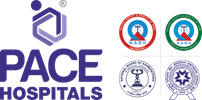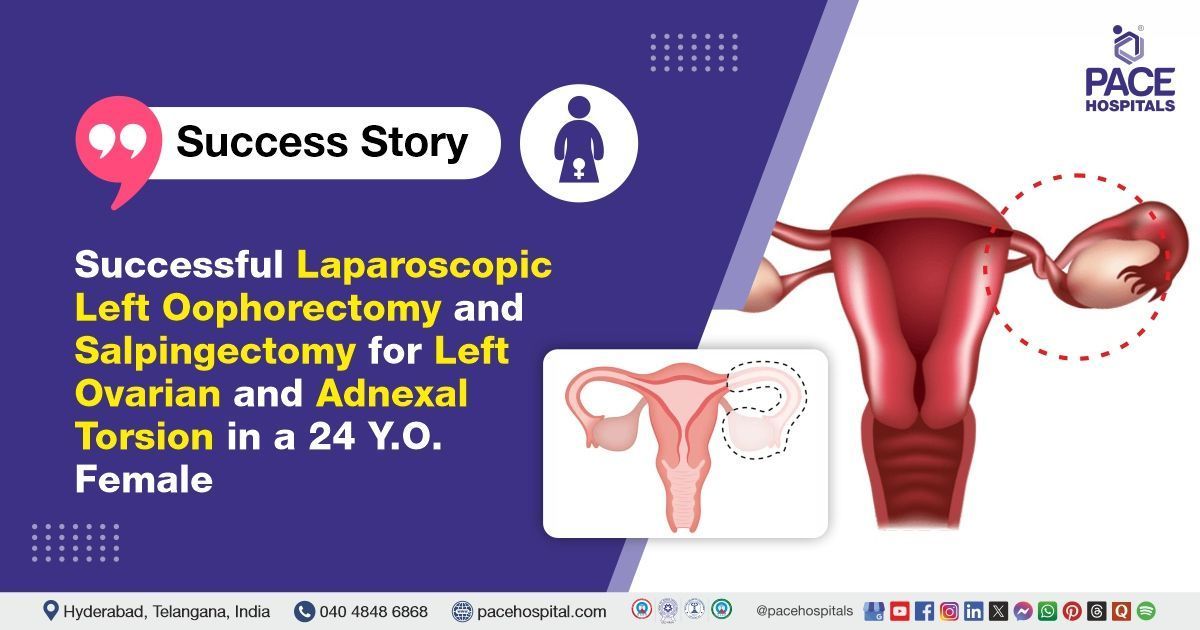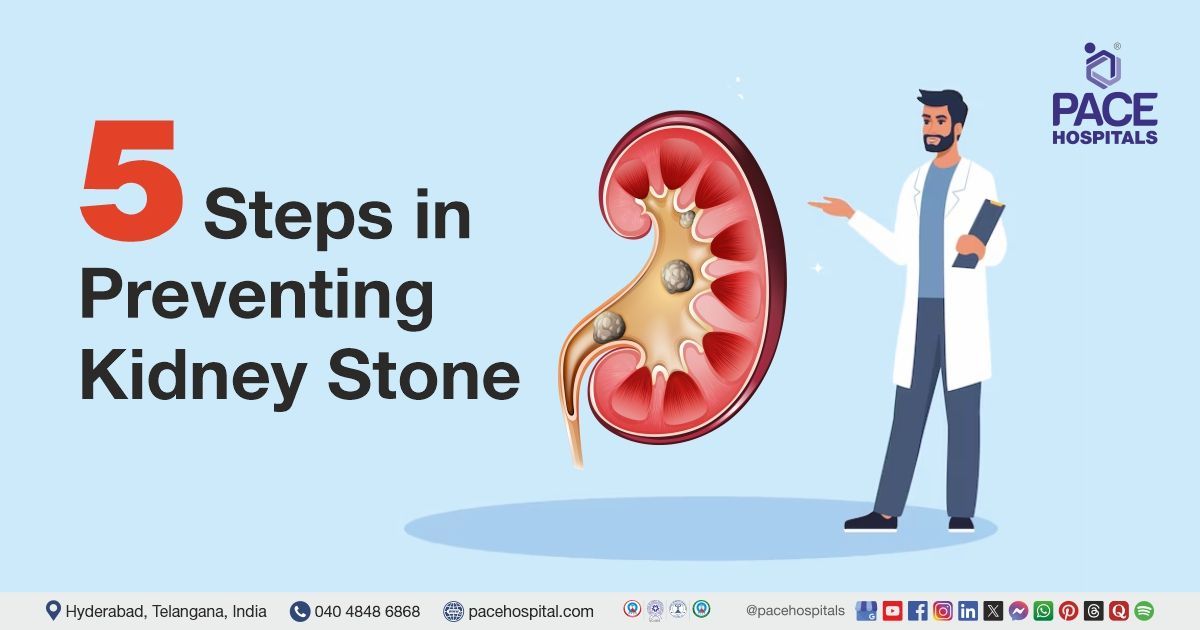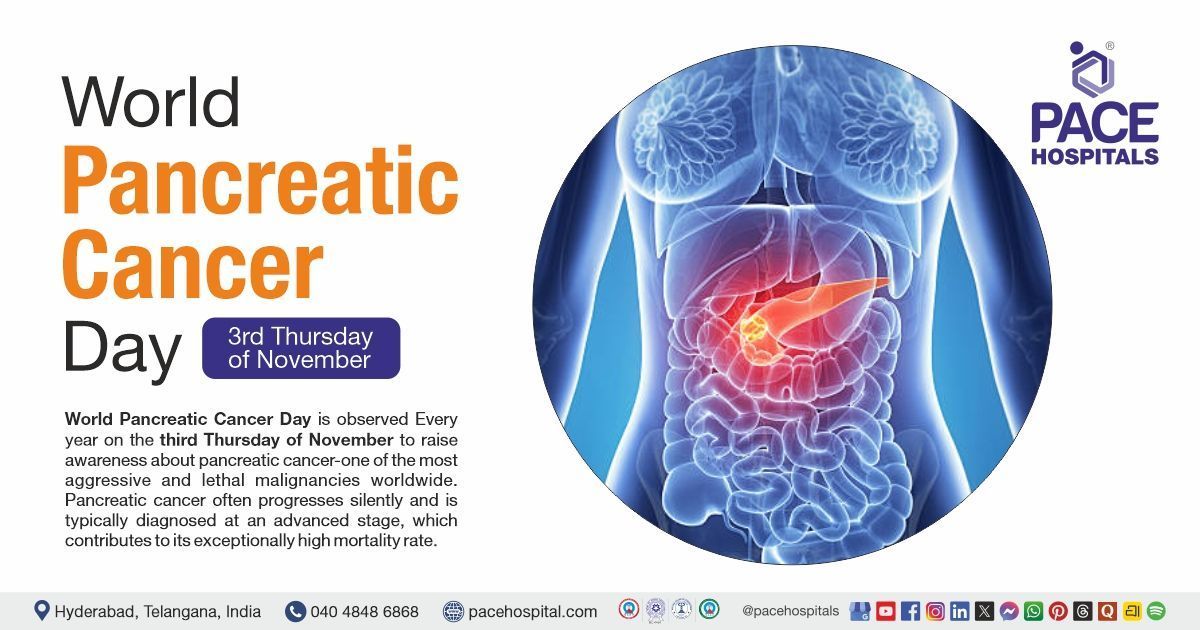Successful Laparoscopic Left Oophorectomy and Salpingectomy for Left Ovarian and Adnexal Torsion in a 24 Y.O. Female
PACE Hospitals
PACE Hospitals' Gynaecology team successfully performed a Laparoscopic Left Oophorectomy with Left Salpingectomy on a 24-year-old female diagnosed with torsion of the left ovary and left adnexa. The procedure aimed to remove the non-viable ovary and fallopian tube, relieve the torsion, and prevent further complications such as tissue necrosis, infection, or long-term reproductive consequences.
Chief Complaints
A 24-year-old female patient with a body mass index (BMI) of 21 presented to the Gynaecology Department at PACE Hospitals, Hitech City, Hyderabad, with complaints of severe pain in the left iliac region for the past 6 hours, associated with one episode of vomiting and nausea. The pain was not relieved by medication, prompting immediate evaluation.
Her last menstrual period (LMP) was on 21st May 2025 (Day 3 at presentation), with the last known regular menstrual period (LLMP) in March 2025. She has regular cycles with occasional missed periods.
Past Medical History
The patient had no known history of hypertension or diabetes. The absence of these comorbid conditions was considered clinically favourable, as it had minimised the risk of intraoperative and postoperative complications and had supported a smoother, more stable recovery in this case.
On Examination
The patient was conscious, coherent, and cooperative. Vital signs were within normal limits. Respiratory system examination revealed normal air entry bilaterally. Cardiovascular system examination showed normal heart sounds without any abnormalities. Abdominal examination revealed tenderness localized to the left iliac region. Breast examination was normal with no lumps detected.
Diagnosis
Upon admission to PACE Hospitals, the patient was thoroughly evaluated by the Gynaecology team, including a detailed review of her medical history and a comprehensive clinical examination. Given her presentation with severe left iliac region pain and associated symptoms, adnexal torsion was clinically suspected.
The patient underwent diagnostic investigations, including pelvic ultrasound with Doppler study and clinical evaluation, which confirmed torsion of the left ovary and left adnexa with signs of ovarian enlargement and compromised blood flow. Laboratory investigations, including complete blood count (CBC) and routine biochemical tests, were within normal limits. No other systemic abnormalities were detected.
Based on the confirmed findings, the patient was advised to undergo
Left Ovarian and Adnexal Torsion Treatment in Hyderabad, India, under the expert care of the Gynaecology Department.
Medical Decision Making
After a detailed consultation with Dr. Mugdha Bandawar, a Gynaecologist, a timely multidisciplinary discussion was held to determine the most appropriate diagnostic and therapeutic approach. Considering the acute presentation of severe left iliac pain, vomiting, and clinical suspicion of ovarian torsion, the team assessed the urgency of the condition and potential complications, including hemoperitoneum.
Further evaluation, including clinical examination and pelvic imaging with Doppler study, confirmed the diagnosis of torsion of the left ovary and adnexa. It was determined that a laparoscopic left oophorectomy with left salpingectomy was identified as the most effective medical approach to relieve symptoms and prevent life-threatening complications such as necrosis and peritonitis.
The patient and her family were informed about her condition, the surgical procedure, its associated risks, and the expected outcome, including the loss of the affected ovary, with plans for postoperative care and follow-up to monitor recovery and reproductive health.
Surgical Procedure
Following the decision, the patient was scheduled to undergo Laparoscopic Left Oophorectomy with Left Salpingectomy surgery in Hyderabad at PACE Hospitals under the expert care of the Gynaecology department.
The following steps were carried out during the procedure:
- Laparoscopic Exploration: Initial laparoscopic inspection revealed a significantly enlarged left ovary (6 x 7 cm) twisted 3-4 times on its axis, appearing gangrenous. The right ovary, fallopian tube, and uterus appeared normal. Approximately 50-80 ml of hemoperitoneum was noted.
- Adnexal Derotation: The left adnexa was carefully derotated to assess viability, but due to gangrene, preservation was not possible.
- Excision of Adnexa: The twisted left ovary and fallopian tube were surgically removed via an extension of the umbilical port incision.
- Hemostasis and Irrigation: Hemostasis was meticulously achieved, followed by thorough irrigation of the peritoneal cavity to clear any blood and debris.
- Closure: The surgical site was closed after ensuring no active bleeding.
Postoperative Care
The postoperative period was uneventful. The patient was closely monitored in the ICU and later shifted to the ward once hemodynamically stable. During her hospital stay, she was administered broad-spectrum antibiotics to prevent infection, proton pump inhibitors for gastric protection, and antiemetics to control nausea and vomiting.
Adequate analgesics were provided for pain management, and intravenous fluids were given to maintain hydration and electrolyte balance. The patient showed steady clinical improvement throughout her stay and was discharged in stable condition with follow-up instructions.
Discharge Medications
Upon discharge, the patient was prescribed oral antibiotics to prevent postoperative infections, along with analgesics and anti-inflammatory medications to manage pain and inflammation. Gastric acid suppressants were advised to protect the stomach, while nutritional supplements were recommended to support healing and enhance immunity. Additionally, a topical antibiotic ointment was provided for local wound care, and an antiseptic gargle was prescribed to maintain oral hygiene.
Advice on Discharge
The patient was advised to avoid heavy lifting and strenuous exercise. She was also instructed to avoid travelling and to rest or work from home for one month. A soft diet with high protein content was recommended to support recovery during this period.
Emergency Care
The patient was informed to contact the emergency ward at PACE Hospitals in case of any emergency or development of symptoms like heavy bleeding, fever, abdominal pain, or vomiting.
Review and Follow-up Notes
The patient was advised to return for a follow-up visit with the Gynaecologist in Hyderabad at PACE Hospitals after one week with the biopsy report.
Conclusion
This case highlights the effective management of left ovarian torsion through timely laparoscopic surgery. The patient’s acute symptoms were promptly addressed, leading to a stable postoperative recovery. Multidisciplinary care and follow-up planning contributed to a positive outcome.
Timely Intervention in Ovarian Torsion for Optimal Gynaecological Outcomes
This case highlights the importance of prompt clinical evaluation and timely intervention in young females presenting with acute abdominal pain. Ovarian torsion is a gynaecological emergency that can lead to loss of ovarian function if not addressed urgently. Early use of diagnostic imaging and laparoscopy allows for accurate diagnosis and immediate treatment.
The surgical decision to perform a laparoscopic left oophorectomy with salpingectomy was guided by intraoperative findings of gangrenous adnexa. Postoperative recovery was smooth, and the patient was hemodynamically stable at discharge. This case reinforces the critical role of a Gynaecologist / Gynaecology doctor in managing acute gynecological conditions effectively.
Share on
Request an appointment
Fill in the appointment form or call us instantly to book a confirmed appointment with our super specialist at 04048486868











